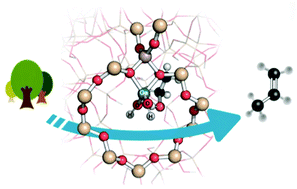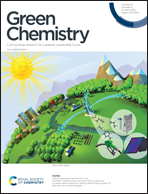Ga/ZSM-5 catalyst improves hydrocarbon yields and increases alkene selectivity during catalytic fast pyrolysis of biomass with co-fed hydrogen†
Abstract
Catalytic fast pyrolysis using the zeolite ZSM-5 is an attractive process for converting lignocellulosic biomass into fuels and chemicals. Ga-modified ZSM-5 has demonstrated improved hydrocarbon yields compared to ZSM-5 due to additional functionality imparted by Ga; however, there is little knowledge of the active Ga species and its role in the catalytic mechanisms. Here, we employ micropyrolyzer – GC-MS experiments and theoretical calculations to demonstrate that a hydrogen-pretreated Ga species (Ga*/ZSM-5) and a reductive environment are critical towards upgrading pine pyrolysis vapors into high yields of alkenes and aromatic hydrocarbons at near atmospheric pressure. The total carbon yield (g C in product per g C in pine) in alkenes and aromatic hydrocarbons under these conditions was 37% compared to 25% for the parent ZSM-5 catalyst. The corresponding carbon yield was only 19% for Ga*/ZSM-5 under inert conditions indicating that both the hydrogen-pretreated Ga* species and reducing atmosphere are required to obtain high hydrocarbon yields. The ratio of carbon in alkenes to carbon in aromatic hydrocarbons increased to 2.5 with Ga*/ZSM-5 under a reductive environment vs. 0.4 for ZSM-5. The carbon yield of alkenes increased with Ga loading; in contrast, increasing catalyst acidity promoted aromatic hydrocarbon production. Experiments conducted with isopropanol demonstrated high selectivity to propene over Ga*/ZSM-5 under reductive environments, indicating enhancement of dehydration reactions. A computational mechanism study was conducted to identify the active Ga species ([GaH2]+, [GaO]+, [Ga(OH)2]+ or [GaH(OH)]+) using the dehydration of isopropanol as a model reaction. Theoretical calculations suggested that [Ga(OH)2]+ and [GaH(OH)]+ are the most likely species responsible for dehydration with 39.7 and 38.8 kcal mol−1 activation energy barriers, respectively, and based on thermodynamic analysis, their ratio in the catalyst is dictated by H2 partial pressure and temperature. The model compound studies and computational results provide mechanistic support for the observed biomass experiments showing increased alkene selectivity.

- This article is part of the themed collection: 2020 Green Chemistry Hot Articles


 Please wait while we load your content...
Please wait while we load your content...
